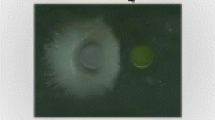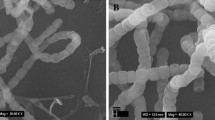Abstract
The discovery of new secondary metabolites is a challenge to biotechnologists due to the emergence of superbugs and drug resistance. Knowledge about biodiversity and the discovery of new microorganisms have become major objectives; thus, new habitats like extreme ecosystems have become places of interest to research. In this context, caatinga is an unexplored biome. The ecosystem caatinga is a rich habitat for thermophilic microbes. Its high temperature and dry climate cause selective microbes to flourish and become established. Actinobacteria (Caat 1-54 genus Streptomyces sp.) isolated from the soil of caatinga was investigated to characterize and map its secondary metabolites by desorption electrospray ionization mass spectrometry imaging (DESI–MSI). With this technique, the production of bioactive metabolites was detected and associated with the different morphological differentiation stages within a typical Streptomyces sp. life cycle. High-resolution mass spectrometry, tandem mass spectrometry, UV–Vis profiling and NMR analysis were also performed to characterize the metabolite ions detected by DESI–MS. A novel compound, which is presumed to be an analogue of the antifungal agent lienomycin, along with the antimicrobial compound lysolipin I were identified in this study to be produced by the bacterium. The potency of these bioactive compounds was further studied by disc diffusion assays and their minimum inhibitory concentrations (MIC) against Bacillus and Penicillium were determined. These bioactive metabolites could be useful to the pharmaceutical industry as candidate compounds, especially given growing concern about increasing resistance to available drugs with the emergence of superbugs. Consequently, the unexplored habitat caatinga affords new possibilities for novel bioactive compound discovery.

ᅟ





Similar content being viewed by others
References
Bull AT, Goodfellow M, Slater JH. Biodiversity as a source of innovation in biotechnology. Annu Rev Microbiol. 1992;46(1):219–46.
Colwell R. Microbial diversity: the importance of exploration and conservation. J Ind Microbiol Biotechnol. 1997;18(5):302–7.
Weber T, Charusanti P, Musiol-Kroll EM, Jiang X, Tong Y, Kim HU, et al. Metabolic engineering of antibiotic factories: new tools for antibiotic production in actinomycetes. Trends Biotechnol. 2015;33(1):15–26.
Leal IR, Jd S, Tabarelli M, Lacher TE Jr. Mudando o curso da conservação da biodiversidade na Caatinga do Nordeste do Brasil. Megadiversidade. 2005;1(1):139–46.
Pacchioni RG, Carvalho FM, Thompson CE, Faustino AL, Nicolini F, Pereira TS, et al. Taxonomic and functional profiles of soil samples from Atlantic forest and Caatinga biomes in northeastern Brazil. Microbiology. 2014;3(3):299–315.
de Oliveira G, Araújo MB, Rangel TF, Alagador D, Diniz-Filho JAF. Conserving the Brazilian semiarid (Caatinga) biome under climate change. Biodivers Conserv. 2012;21(11):2913–26.
Brasil I. Manual Técnico da Vegetação Brasileira (Manuais Técnicos em Geociências no 1). Fundação Instituto Brasileiro de Geografia e Estatística (IBGE), Rio de Janeiro, Brasil. 1992.
Prado DE. As Caatingas da America do Sul. In: Leal IR, Tabarelli M, da Silva JMC, editors. Ecologia e conservação da Caatinga. Brasil: Editora Universitária UFPE; 2003. p. 3–74.
Waksman SA. Morphology and life cycle. In: Verdoorn F, editor. The actinomycetes: their nature, occurrence, activities, and importance. Washington, D.C.: Chronica Botanica; 1950. p. 45–68.
Bérdy J. Are actinomycetes exhausted as source of secondary metabolites? In: Debabov VG, Dudnik YV,Danilenko V, editors. Biotehnologija, proceedings of the 9th international symposium on the biology ofactinomycetes, Moscow 1994. All-Russia Scientific Research Institute;1995. p. 13–34.
Flardh K, Buttner MJ. Streptomyces morphogenetics: dissecting differentiation in a filamentous bacterium. Nat Rev Microbiol. 2009;7(1):36–49.
Basilio A, Gonzalez I, Vicente M, Gorrochategui J, Cabello A, Gonzalez A, et al. Patterns of antimicrobial activities from soil actinomycetes isolated under different conditions of pH and salinity. J Appl Microbiol. 2003;95(4):814–23.
Lechevalier MP. Identification of aerobic actinomycetes of clinical importance. J Lab Clin Med. 1968;71(6):934–44.
de Vasconcellos RLF, da Silva MCP, Ribeiro CM, Cardoso EJBN. Isolation and screening for plant growth-promoting (PGP) actinobacteria from Araucaria angustifolia rhizosphere soil. Sci Agric. 2010;67(6):743–6.
Andreola F, Fernandes SAP. A microbiota do solo na Agricultura Organica e no Manejo das Culturas. In: da Silveira APD, Freitas S, editors. Microbiota do solo e qualidade ambiental. Campinas: Instituto Agronômico de Campinas-IAC; 2007. p. 21–38.
Li B, Comi TJ, Si T, Dunham SJ, Sweedler JV. A one-step matrix application method for MALDI mass spectrometry imaging of bacterial colony biofilms. J Mass Spectrom. 2016;51(11):1030–5.
Li B, Dunham SJ, Ellis JF, Lange JD, Smith JR, Yang N, et al. A versatile strategy for characterization and imaging of drip flow microbial biofilms. Anal Chem. 2018;90(11):6725–34.
Lanni EJ, Masyuko RN, Driscoll CM, Aerts JT, Shrout JD, Bohn PW, et al. MALDI-guided SIMS: multiscale imaging of metabolites in bacterial biofilms. Anal Chem. 2014;86(18):9139–45.
Yang Y-L, Xu Y, Straight P, Dorrestein PC. Translating metabolic exchange with imaging mass spectrometry. Nat Chem Biol. 2009;5(12):885.
Liu W-T, Yang Y-L, Xu Y, Lamsa A, Haste NM, Yang JY, et al. Imaging mass spectrometry of intraspecies metabolic exchange revealed the cannibalistic factors of Bacillus subtilis. Proc Natl Acad Sci. 2010;107(37):16286–90.
Chen H, Venter A, Cooks RG. Extractive electrospray ionization for direct analysis of undiluted urine, milk and other complex mixtures without sample preparation. Chem Commun. 2006;19:2042–4.
Campbell IS, Ton AT, Mulligan CC. Direct detection of pharmaceuticals and personal care products from aqueous samples with thermally-assisted desorption electrospray ionization mass spectrometry. J Am Soc Mass Spectrom. 2011;22(7):1285.
Golf O, Strittmatter N, Karancsi T, Pringle SD, Speller AV, Mroz A, et al. Rapid evaporative ionization mass spectrometry imaging platform for direct mapping from bulk tissue and bacterial growth media. Anal Chem. 2015;87(5):2527–34.
Watrous JD, Dorrestein PC. Imaging mass spectrometry in microbiology. Nat Rev Microbiol. 2011;9(9):683.
Jackson AU, Werner SR, Talaty N, Song Y, Campbell K, Cooks RG, et al. Targeted metabolomic analysis of Escherichia coli by desorption electrospray ionization and extractive electrospray ionization mass spectrometry. Anal Biochem. 2008;375(2):272–81.
Sica VP, Raja HA, El-Elimat T, Oberlies NH. Mass spectrometry imaging of secondary metabolites directly on fungal cultures. RSC Adv. 2014;4(108):63221–7.
Tata A, Perez CJ, Ore MO, Lostun D, Passas A, Morin S, et al. Evaluation of imprint DESI–MS substrates for the analysis of fungal metabolites. RSC Adv. 2015;5(92):75458–64.
Tata A, Perez C, Campos ML, Bayfield MA, Eberlin MN, Ifa DR. Imprint desorption electrospray ionization mass spectrometry imaging for monitoring secondary metabolites production during antagonistic interaction of fungi. Anal Chem. 2015;87(24):12298–305.
Angolini CFF, Vendramini PH, Araújo FD, Araújo WL, Augusti R, Eberlin MN, et al. Direct protocol for ambient mass spectrometry imaging on agar culture. Anal Chem. 2015;87(13):6925–30.
Prideaux B. Imaging cellular and tissue architecture. In: Howard GC, Brown WE, Auer M, editors. Imaging life: biological systems from atoms to tissues. New York: Oxford University Press; 2014. p. 169–390.
Peti APF. Identificação de agentes antimicrobianos produzidos por actinobactérias de solo com potencial aplicação no controle da mastite bovina. PhD dissertation. São Paulo: Universidade de São Paulo; 2016.
Pawlak J, Zielinski J, Golik J, Gumieniak J, Borowski E. The structure of lienomycin, a pentaene macrolide antitumor antibiotic. J Antibiot. 1980;33(9):989–97.
Milhaud J, Ponsinet V, Takashi M, Michels B. Interactions of the drug amphotericin B with phospholipid membranes containing or not ergosterol: new insight into the role of ergosterol. Biochim Biophys Acta. 2002;1558(2):95–108.
Sunazuku T, Omura S, Iwasaki S, Omura S. Chemical modification of macrolides. In: Omura S, editor. Macrolide antibiotics, chemistry, biology, and practice. Orlando: Academic; 1984. p. 99–164.
Martin J-F. Biosynthesis of polyene macrolide antibiotics. Annu Rev Microbiol. 1977;31(1):13–36.
Nakagomi K, Takeuchi M, Tanaka H, Tomizuka N, Nakajima T. Studies on inhibitors of rat mast cell degranulation produced by microorganisms. J Antibiot. 1990;43(5):462–9.
Ujikawa K. Antibióticos antifúngicos produzidos por actinomicetos do Brasil e sua determinação preliminar nos meios experimentais. Rev Bras Cienc Farm. 2003;39(2):149–58.
Acknowledgements
We are grateful to Prof. Dr. Itamar Soares de Melo for providing us with the strain Caat 1-54; Uzma Muzzammal, German Reyes and George Bikopolous for their assistance in the microbiology facility and providing us the Bacillus subtilis; and Ayat Yaseen for providing us the E. coli strain. We acknowledge the financial support from Natural Sciences and Engineering Research Council of Canada (NSERC), Coordenação de Aperfeiçoamento de Pessoal de Nível Superior (CAPES) and Fundação de Amparo à Pesquisa do Estado de São Paulo (FAPESP) (2016-22023-0).
Author information
Authors and Affiliations
Corresponding author
Ethics declarations
Conflict of interest
No conflict of interest declared.
Electronic supplementary material
ESM 1
(PDF 1234 kb)
Rights and permissions
About this article
Cite this article
Rodrigues, J.P., Prova, S.S., Moraes, L.A.B. et al. Characterization and mapping of secondary metabolites of Streptomyces sp. from caatinga by desorption electrospray ionization mass spectrometry (DESI–MS). Anal Bioanal Chem 410, 7135–7144 (2018). https://doi.org/10.1007/s00216-018-1315-0
Received:
Revised:
Accepted:
Published:
Issue Date:
DOI: https://doi.org/10.1007/s00216-018-1315-0




